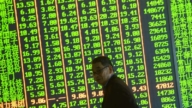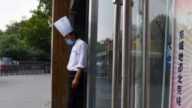【新唐人2013年01月21日訊】大陸國家統計局相繼公布年度宏觀經濟、和居民收入基尼係數,以及勞動人口數變動等統計數據。不過這些數據,讓經濟學者批評﹕「連童話都不敢這麼寫!」也有專家認為,統計局為呈現「經濟增速減緩」的真相,或防「水份過高」,只得「調控」出符合政策趨向的數據,也就是說,統計數據是「為政治服務」的。
有媒體質問﹕大陸官方經濟數據究竟有多少水份?背後是否隱含著複雜「特殊國情」的政治考量﹖或者更有官僚體系浮誇自保的習性﹖
從最近大陸統計局公布的幾個數據來看,有三個報跌的數據,包括GDP、基尼係數、和勞動年齡人口。經濟界忙著分析這組數據的同時,也注意到當局公布數據背後的用意。
統計局公布,去年中國全年GDP增長7.8%。台灣《中國時報》引述大陸一位在部委任職人士的話說,多數省市自行初估的GDP增長都超過兩位數,全國數據卻能得出「破八」結論,背後自有反映「穩中求進」的政策考量。
《新唐人》特約經濟評論專家傑森‧馬表示,中國的經濟數據,都是官方給出來的,缺乏可以參照的數據依據。
《新唐人》特約經濟評論專家傑森‧馬﹕「在(2012年)後半年,中共又開始調用它的老招數,靠給地方政府搞大型的基礎建設,修公路,修一些亂七八糟的城市建設,用這種方法準備刺激經濟,它只能靠這種非常低調的…政府往中國經濟裡頭灌錢,用錢來刺激經濟,用印鈔票的方式來刺激經濟,結果的話就是,一刺激,經濟數據很好看的樣子!老百姓的通脹就起來了,要是稍微控制通脹,中國經濟又疲軟了。」
近年中國貧富差距拉大,導致社會矛盾加劇。而貧富差距的測評係數,正是基尼係數。統計局報出的中國全國居民收入的「基尼係數」,從2003年的0.479,到2008年的0.491,然後「逐步回落」。當局否認貧富差距拉大。
大陸經濟學家許小年在微博上說,那個基尼係數,「連童話都不敢這麼寫」。
民間普遍不相信官方數據,「西南財經大學」發佈的「中國家庭金融調查」,2010年中國家庭基尼係數0.61,遠遠高於0.44的全球平均水準。報導說,中共當局刻意低估,顯然有意粉飾貧富差距擴大的社會矛盾。
傑森‧馬﹕「第一個是房地產的問題,08年、09年在中國經濟刺激情況下,中國房地產暴漲,一定使中國經濟整個貧富分化更嚴重,另外,在整個鈔票過度發行過程中,相對來說,有投資渠道的人賺錢最多,而一般靠職工資,把錢存到銀行的老百姓吃虧最大,應該也是證明中國貧富分化越來越嚴重。」
經濟學博士、美國資深經濟分析師 簡天倫:「消費佔國內生產總值GDP的比例,實際上是逐年下降,從70年代、60年代開始一直下降,下降到現在百分之30多一點,下降的原因,我覺得主要是分配的不公,就是收入的不均,尤其房價過高,所以他們很大一部分的收入都用於支付房價,還有醫療保險,還有教育等等。」
統計局還公布,中國人口2012年增加670萬人,總人口達到13億5400萬人,不包括香港與澳門。不過15歲到59歲的勞動人口卻減少345萬人,來到9億3700萬人。這是中國勞動年齡人口,第一次出現了絕對下降。
簡天倫:「換句話來說,就是過去的所謂獨生子女政策的人口紅利,給中國帶來的GDP增長,現在已經成負效應,因為現在勞動人口實際上在下降,而且以後很可能還會持續下降。」
專家表示,勞動人口減少的同時,老年人口逐年增加,這是北京當局面臨的重大挑戰之一。各界擔心中共當局如何照顧日益增多的老年人。大陸60歲以上老年人口已達1億9400萬人。
採訪/朱智善 編輯/周平 後製/鍾元
CCP’s Statistics to “Serve Its Political Needs”
China’s National Bureau of Statistics (NBS)
recently announced the latest economic data.
This included last year’s GDP, the Gini coefficient,
and the working-age population’ figure.
Economists question the authenticity of those numbers,
saying “they are more fictional than fantasy stories.”
Other experts remark that China’s NBS has to “adjust”
the statistics to accommodate the truth of “economic slowdown,” yet to avoid giving an inflated number.
In other words, the statistics have to meet
the political needs of the Chinese Communist Party (CCP).
Lately, some media reports queried again how real
the CCP’s official economic data is.
The article presented the following questions: Is there
any complex political considerations about “China’s special national situation” behind the statistics?
Has it reflected the boastfulness and the selfishness
of the CCP’s bureaucracy?
According to the data published by China’s NBS,
three numbers were reported to have dropped.
They are annual GDP growth, the Gini coefficient,
and the figure for working-age population.
Analyzing these statistics in depth, the economic circles
have noticed the regime’s real political purpose behind it.
The NBS officially announced that China’s GDP grew
by 7.8% in 2012.
Taiwan-based China Times newspaper cited an incumbent
mainland Ministry official that most provinces had estimated a double digit GDP growth.
However, the final number for the whole nation
dropped below 8%.
This clearly suggests that the political factors behind it
require the number to look more like a “steady advance.”
NTD special Economic Review Expert Jason Ma remarked,
all China’s economic data are given by the CCP regime, and thus lacks independent resources to compare with.
Jason Ma (NTD special Economic Review Expert):
”In the second half of 2012, the CCP dusted off its old tricks to stimulate the economy.
That is, to start more infrastructure local governments’
projects, like building roads or other unnecessary urban constructions.
This is the only approach it can think of.
The government continuously pours money into China’s
Economy, or simply prints more money as a stimulus.
As a result, very nice-looking economic data are produced
but the inflation becomes worse for ordinary people.
On the contrary, if you turn to solve the inflation issue,
the economy will be weakened.”
In recent years, the gap between rich and poor has widened
in China, leading to more intensive social conflicts.
The Gini coefficient is the index that measures
the level of inequality.
It is officially reported that China’s Gini coefficient of
national-wide personal income was 0.479 in 2003, then it increased to 0.491 in 2008, and dropped again after that.
In other words, the CCP authorities deny
that income inequality is growing in China.
Chinese economist Xu Xiaonian wrote on his microblog site,
“That (the official) Gini coefficient is more fictional than fantasy stories.”
Most Chinese civilians also show little faith
in the CCP’s statistics.
A China household finance survey performed by
Southwestern University of Finance and Economics,
reported that China’s household income’ Gini coefficient
was 0.61 in 2012, which was much higher than the global average of 0.44.
Some thus remarked that the CCP regime consciously
underestimates the Gini coefficient,
which obviously aimed at hiding the worse social conflicts
resulting from the larger gap between rich and poor.
Jason Ma: ”The first reason (for worse income inequality)
lies in the housing market.
Under the economic stimulus, there was a boom
in the real estate industry around 2008 and 2009.
This definitely increased the gap
between rich and poor.
In addition, during the excessive issue of currencies, people
with more available investment channels were capable of making more money.
In comparison, the working class who keep their money
in the bank suffered the most.
This also indicates that the gap between rich and poor
should have become larger in China.”
Jian Tianlun (PhD in Economics, senior economic analyst):
”In fact, China’s domestic consumption’ GDP contribution has been consistently dropping since the 1960’s-1970’s.
Now it has dropped to right over 30%.
I think the main reason for this drop is unfair distribution
of income, or income inequality.
In particular, the housing price is too high, and civilians
have to spend most of their income on buying a house.
There are also similar problems in other fields,
like health care and education.”
China’s NBS also reported that China’s total population
reached 1.354 billion in 2012, with an annual increment of 6.7 million.
Yet, the working population between the age of 15 and 59
had dropped by 3.45 million, reaching 0.937 billion.
This is the first time that China sees
a decline in working population.
Jian Tianlun: ”In other words, China’s GDP growth
used to benefit from the one-child policy.
Now its negative effect shows up as the working-age
population starts to decrease.
It is very probable that such a drop
will be a lasting trend.”
Expert remarks that the decreasing working population
and the increasing aging population has become a big challenge to the CCP.
It is especially worrying how the regime will take care
of those old people, as the population over 60 has totaled 194 million in mainland China.




























